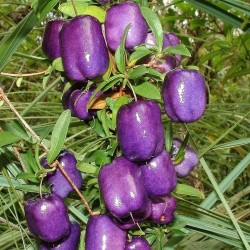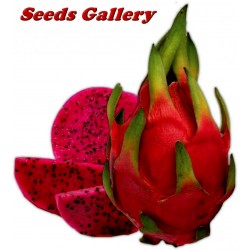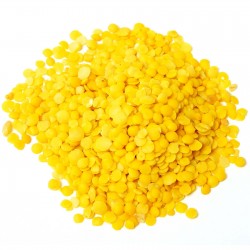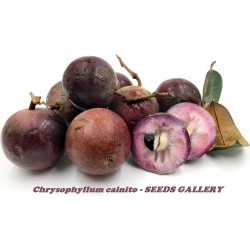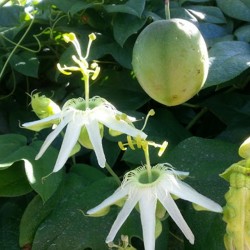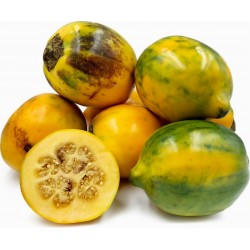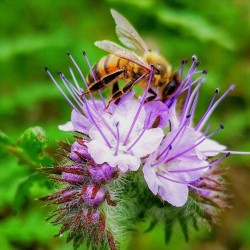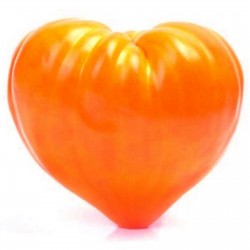Seeds Gallery EU,
5/
5
<h2 class="">Pitaya, Pitahaya Fruit, Dragon Fruit Seeds With Red Meat</h2>
<h2><span style="color: #ff0000;"><strong>Price for Package of 10 or 20 seeds.</strong></span></h2>
<p>DRAGON FRUIT. Truly one of God's wonders!</p>
<p>Pitaya Fruit, Pitahaya Fruit or commonly known as the Dragon fruit is among the most nutritious and wonderful exotic fruits. It is a favorite to many, particularly people of Asian origin. It features a mouth watering light sweet taste, an intense shape and color, not forgetting its outstanding flowers. In addition to being tasty and refreshing, this beautiful fruit boasts of a lot of water and other vital minerals with varied nutritional ingredients.</p>
<p>Round, often red colored fruit with prominent scales. The thin rind encloses the large mass of sweetly flavored white or red pulp and small black seeds. Dragon fruits have fleshy stems reaching from a few inches up to 20ft long (in mature plants). Flowers are ornate and beautiful, and many related species are propagated as ornamentals. Pitahaya plants can have up to 4-6 fruiting cycles per year.</p>
<p>Family: Cactaceae family</p>
<p>Origin: Mexico and South America</p>
<p>Dragon fruit plant is a night flowering vine-like cactus, the beautiful yellowish flower is about 1 foot long and 9 inches wide, bell shaped and very fragrant, they open during the early evening and wilt by daybreak. The fruit is oblong and has unique appearance because of its bright pink to red, green tipped overlapping scales rind. The edible portion is white or red, with hundreds of tiny black seeds. Its taste is sweet and juicy similar to that of pear, kiwi and watermelon. Dragon fruit is now grown commercially in Asia in places like Philippines, Thailand and Vietnam.</p>
<p>Health Benefits:</p>
<ol>
<li>Dragon fruit help to lower blood glucose levels in type 2 diabetes.</li>
<li>Dragon fruit prevent formation of cancer causing free radicals.</li>
<li>Dragon fruit helps moisturize and smoothen skin and decrease bad cholesterol level.</li>
<li>Dragon fruit helps improve appetite.</li>
<li>Dragon fruit can enhance the body metabolism because of its protein content.</li>
<li>Dragon fruit helps improve digestion and reduce fat.</li>
<li>Dragon fruit helps maintain the health of the eyes.</li>
<li>Dragon fruit helps strengthen the bones and teeth.</li>
<li>Dragon fruit helps in tissue development.</li>
<li>Dragon fruit promotes healing of cuts and bruise.</li>
<li>Dragon fruit helps improve memory.</li>
</ol>
<div>
<table cellspacing="0" cellpadding="0" border="1">
<tbody>
<tr>
<td colspan="2" width="100%" valign="top">
<p><span style="color: #008000;"><strong>Sowing Instructions</strong></span></p>
</td>
</tr>
<tr>
<td valign="top" nowrap="nowrap">
<p><span style="color: #008000;"><strong>Propagation:</strong></span></p>
</td>
<td valign="top">
<p><span style="color: #008000;">Seeds / Cuttings</span></p>
</td>
</tr>
<tr>
<td valign="top" nowrap="nowrap">
<p><span style="color: #008000;"><strong>Pretreat:</strong></span></p>
</td>
<td valign="top">
<p><span style="color: #008000;">0</span></p>
</td>
</tr>
<tr>
<td valign="top" nowrap="nowrap">
<p><span style="color: #008000;"><strong>Stratification:</strong></span></p>
</td>
<td valign="top">
<p><span style="color: #008000;">0</span></p>
</td>
</tr>
<tr>
<td valign="top" nowrap="nowrap">
<p><span style="color: #008000;"><strong>Sowing Time:</strong></span></p>
</td>
<td valign="top">
<p><span style="color: #008000;">all year round</span></p>
</td>
</tr>
<tr>
<td valign="top" nowrap="nowrap">
<p><span style="color: #008000;"><strong>Sowing Depth:</strong></span></p>
</td>
<td valign="top">
<p><span style="color: #008000;">Light germinator! Just sprinkle on the surface of the substrate + gently press</span></p>
</td>
</tr>
<tr>
<td valign="top" nowrap="nowrap">
<p><span style="color: #008000;"><strong>Sowing Mix:</strong></span></p>
</td>
<td valign="top">
<p><span style="color: #008000;">Coir or sowing mix + sand or perlite</span></p>
</td>
</tr>
<tr>
<td valign="top" nowrap="nowrap">
<p><span style="color: #008000;"><strong>Germination temperature:</strong></span></p>
</td>
<td valign="top">
<p><span style="color: #008000;"> about 25-28 ° C</span></p>
</td>
</tr>
<tr>
<td valign="top" nowrap="nowrap">
<p><span style="color: #008000;"><strong>Location:</strong></span></p>
</td>
<td valign="top">
<p><span style="color: #008000;">bright + keep constantly moist not wet</span></p>
</td>
</tr>
<tr>
<td valign="top" nowrap="nowrap">
<p><span style="color: #008000;"><strong>Germination Time:</strong></span></p>
</td>
<td valign="top">
<p><span style="color: #008000;"> 2-4 Weeks</span></p>
</td>
</tr>
<tr>
<td valign="top" nowrap="nowrap">
<p><span style="color: #008000;"><strong>Watering:</strong></span></p>
</td>
<td valign="top">
<p><span style="color: #008000;">Water regularly during the growing season</span></p>
</td>
</tr>
<tr>
<td valign="top" nowrap="nowrap">
<p><span style="color: #008000;"><strong> </strong></span></p>
</td>
<td valign="top">
<p><br><span style="color: #008000;"><em>Copyright © 2012 Seeds Gallery - Saatgut Galerie - Galerija semena. All Rights Reserved.</em></span></p>
</td>
</tr>
</tbody>
</table>
<p></p>
<h2>WIKIPEDIA:</h2>
<p><i><b>Hylocereus undatus</b></i><span>, the </span><b>white-fleshed pitahaya</b><span>, is a species of </span>Cactaceae<span> and is the most cultivated species in the genus. It is used both as an ornamental vine and as a fruit crop - the </span><b>pitahaya</b><span> or </span><b>dragon fruit</b><span>. The native origin of the species has never been resolved.</span></p>
<h2><span class="mw-headline" id="Common_names">Common name</span></h2>
<ul>
<li>English: pitahaya, dragon fruit, night blooming Cereus, Strawberry Pear, Belle of the Night, Cinderella Plant, Jesus in the Cradle</li>
<li>Estonian: maasik-metskaktus</li>
<li>French: pitaya, fruit du dragon, cierge-lézard, poire de chardon</li>
<li>German: Drachenfrucht, Distelbirne</li>
<li>Greek: Φρούτο του δράκου (fruto tu draku)</li>
<li>Hawaiian: <i>panini-o-ka-puna-hou</i> ("Punahou cactus") - a famous specimen still grows at Punahou School</li>
<li>Japanese: pitaya (<span lang="ja" xml:lang="ja">ピタヤ</span>), dragon fruit (<span lang="ja" xml:lang="ja">ドラゴンフルーツ</span>),</li>
<li>Portuguese: pitaia, cato-barse, cardo-ananaz, rainha da noite</li>
<li>Spanish: pitahaya roja (Colombia, Mexico, Venezuela); flor de caliz, pitajava (Puerto Rico); junco, junco tapatio, pitahaya orejona, reina de la noche, tasajo (Mexico)</li>
<li>Swedish: skogskaktus, röd pitahaya</li>
<li>Vietnamese: thanh long</li>
<li>Thai: แก้วมังกร (kaeo mangkon)</li>
<li>Malay: buah naga. pronounce:boo-ah naa-gaa</li>
<li>Chinese: <span lang="zh-hans" xml:lang="zh-hans">火龙果</span>; pinyin: <i><span lang="zh-latn-pinyin" xml:lang="zh-latn-pinyin">huǒlóngguǒ</span></i></li>
<li>Italian: Pitahaya, Frutto del Drago</li>
</ul>
<h2><span class="mw-headline" id="Etymology">Etymology</span></h2>
<p>Greek "hyle" - wood, matter, Latin "cereus" - waxen, Latin "undatus" - wavy edges of the ribs.</p>
<h2><span class="mw-headline" id="History">History</span></h2>
<div class="thumb tleft">
<div class="thumbinner"><img alt="" src="https://upload.wikimedia.org/wikipedia/commons/thumb/a/a0/Hylocereus_undatus_in_bloom_in_Kona.jpg/220px-Hylocereus_undatus_in_bloom_in_Kona.jpg" width="220" height="147" class="thumbimage">
<div class="thumbcaption">
<div class="magnify"></div>
<i>Hylocereus undatus</i> in bloom in Kona, Hawaii</div>
</div>
</div>
<p>There is a locally famous cactus hedge on a lava rock wall of the Punahou School in Honolulu, the hedge of Kapunahou.</p>
<p>In 1836, Mrs. Bingham planted the hedge<sup id="cite_ref-2" class="reference">[2]</sup> of <i>Hylocereus undatus</i>, the famed cactus known in Hawaii as <i>panini o kapunahou</i>. Its exotic blossoms still bloom during the closing summer months on the Punahou walls. The hedge is on two sides of the school and about three hundred meters long.</p>
<p>From July to as late as October the hedge blooms and several times there is a wall of white flowers hundreds of yards long. Supposedly all the <i>H. undatus</i> in Hawaii came from the wall of Punahou School. People used to come in the evenings from all over the island to see them blooming and "borrow" some cuttings so that now they have this species all over the islands.</p>
<div class="thumb tleft">
<div class="thumbinner"><img alt="" src="https://upload.wikimedia.org/wikipedia/commons/thumb/c/c6/Night_Flowering_Cereus_Lanikai.JPG/220px-Night_Flowering_Cereus_Lanikai.JPG" width="220" height="298" class="thumbimage">
<div class="thumbcaption">
<div class="magnify"></div>
Hylocereus undatus overlooking Lanikai and Na Mokulua</div>
</div>
</div>
<h2><span class="mw-headline" id="Origin_and_habitat">Origin and habitat</span></h2>
<p><i>Hylocereus undatus</i> is lithophytic or hemiepiphytic. It is widely distributed through the tropics in cultivation. Like all true cacti, the genus originates in the Americas, but the precise origin of the species H. undatus is uncertain and it may be a hybrid. Hylocereus undatus is a sprawling or vining, terrestrial or epiphytic cactus. They climb by use of aerial roots and can reach a height 10 meters or more growing on rocks and trees. The genus is very variable and closely related to Selenicereus.</p>
<h2><span class="mw-headline" id="Systematics">Systematics</span></h2>
<p>This species is closely related to <i>H. ocamponis</i> and <i>H. escuintlensis</i>.</p>
<h2><span class="mw-headline" id="Description">Description</span></h2>
<div class="thumb tright">
<div class="thumbinner"><img alt="" src="https://upload.wikimedia.org/wikipedia/commons/thumb/9/9f/Dragonfruit_Chiayi_market.jpg/220px-Dragonfruit_Chiayi_market.jpg" width="220" height="165" class="thumbimage">
<div class="thumbcaption">
<div class="magnify"></div>
The Red Pitahaya at the Chiyai market, Taiwan</div>
</div>
</div>
<div class="thumb tright">
<div class="thumbinner"><img alt="" src="https://upload.wikimedia.org/wikipedia/commons/thumb/9/9c/Hylocereus_undatus_111.JPG/220px-Hylocereus_undatus_111.JPG" width="220" height="339" class="thumbimage">
<div class="thumbcaption">
<div class="magnify"></div>
The flowers in Rome</div>
</div>
</div>
<p>Dragonfruit stems are scandent (climbing habit), creeping, sprawling or clambering, and branch profusely. There can be 4-7 of them, between 5 and 10 m or longer, with joints from 30–120 cm or longer, and 10–12 cm thick; with generally three ribs; margins are corneous (horn-like) with age, and undulate.</p>
<p>Areoles, that is, the small area bearing spines or hairs on a cactus, are 2 mm across with internodes 1–4 cm. Spines on the adult branches are 1-3, 2–4 mm long, being acicular (needle-like) to almost conical, and grayish brown to black in colour and spreading, with a deep green epidermis.</p>
<p>The scented, nocturnal flowers are 25–30 cm long, 15–17 cm wide with the pericarpel 2.5–5 cm long, about 2.5 cm thick, bracteoles ovate, acute, to 2.5 to less than 4 cm long; receptacle about 3 cm thick, bracteoles are linear-lanceolate, 3–8 cm long; outer tepals lanceolate-linear to linear, acuminate (tapering to a point), being 10–15 cm long, 10–15 mm wide and mucronate (ending in a short sharp point). Their colour is greenish-yellow or whitish, rarely rose-tinged; inner tepals are lanceolate (tapering to a point at the tip) to oblanceolate (i.e. more pointed at the base), up to 10–15 cm long about 40 mm wide at widest point, and mucronate, unbroken, sharp to acuminate (pointed), and white. Stamens 5–10 cm long, are declinate, inserted in one continuous zone from throat to 35 mm above the pericarpel and cream. The style (bearing the stigma) to 17, they are 5-24.5 cm long, stout, 6–8 mm thick, cream, and up to 26 stigma lobes, they can be whole or sometimes split at the top, cream, about 25 mm long. Nectar chambers are 30 mm long.</p>
<p>The fruit is oblong to oval, to 6–12 cm long, 4–9 cm thick, red with large bracteoles, with white pulp and seeds are edible; seeds are black.</p>
<h2><span class="mw-headline" id="Cost">Cost</span></h2>
<p>Dragonfruit cost about £1-2.5 each in the UK, PHP 3,000-5,000/kg in Indang, Philippines. In Taiwan they are about 37 NT each and, depending on the season, can be found in Hong Kong for 17 HKD for 3 (6.3HKD/per). In Germany, they can be found for EUR 2-5 (2015) at some supermarkets. In southern California, USA they cost around $6/lb ($13.20/kg) In Vietnam, they cost around 8000-15000 VND (~£0.35 / US$0.50).</p>
</div><script src="//cdn.public.n1ed.com/G3OMDFLT/widgets.js"></script>
V 12 R

